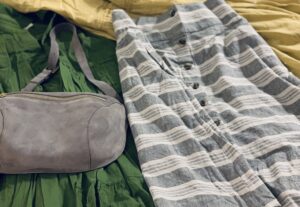
What is sustainable fashion all about?
What it is all about are these basic things: supporting well-meaning brands, supporting local brands, knowing about fabrics and production, caring about the longevity of what one buys and wears, and being sensitive to the environmental impact of all that. Sustainable clothing often gets a bad rap for being costly. All those extra efforts and precautions related to transparency and environmental impact must come at a price, right? Wrong. As this article has shown, there is a growing number of ecologically and ethically sound clothing labels that are as kind to your wallet as they are to this planet.
And as I entered a world of organic materials like jute, cane, raffia and hemp, the synthetic variants like nylon and polyester fell away and literally so. Already a picky consumer, now I was reading every word in the description looking for the usual suspects like polyester.
I have a confession here: in the course of researching for this feature and looking up the various brands mentioned here, I ended up buying and wish-listing half a wardrobe worth of stuff from them. While I was already a consumer of a couple of these and never needed to look elsewhere much (try wearing organic cotton and you will know what I mean), I am now more than happy to report that the options out there for conscious consumers are many”still doesn’t mean we go berserk shopping, but just knowing that there are options should be a relief. Also, it’s not just that the options are many, but that the aesthetics of what is on offer stand out too. This story is only going to get bigger and better from now on.
I close this piece with a vegan fanny bag, a gorgeous patchwork jacket made with scraps, and a dress and a skirt made out of hemp in my wardrobe. The rest are well on their way, and some, as I just mentioned, are on my wishlist.
- Make alternative more accessible and affordable. Use powerful storytelling to get people excited about recycled and sustainable contents in their clothing. Address misconceptions around the quality of recycled materials.
- Encourage consumers to give their old clothes for recycling, and facilitate the same.
- Help consumers understand – and appreciate – the concept of product longevity and how taking proper care of their garments with regard to washing, drying and ironing can keep these in good condition for a long time. Spread the word on the two Rs, repair and reuse.
- Use leftover garment and scraps to make accessories like bags and tags.
- Work with innovative alternative fabrics that have minimum impact on the environment.
- Reduce the use of resource-intensive fibres like cotton.
- Source raw materials such as cotton from certified sustainable sources, including organic, Fairtrade, and Better Cotton Initiative, and support energy efficiency for farmers and producers.
- Reduce or eliminate the use of toxic materials and chemicals.
- Reduce water consumption.
- Improve the efficiency of electricity use including lighting (energy-efficient bulbs), electric motors, and heating systems.
- Review the types and levels of fuels used (coal, oil, biomass), install energy-efficient boilers, collect and recycle heat energy from steam water, and so on.
- Support supply chain partners with a commitment to energy efficiency.
- Work with industry partners to reduce and remove water use from dyeing, stone-washing and finishing processes.
- Take action to increase energy efficiency in the transportation and packaging of products.
- Provide energy-efficient care instructions to their consumers.
- Basically, have a business model that enables product longevity, repair, and other forms of sustainable fashion consumption.

